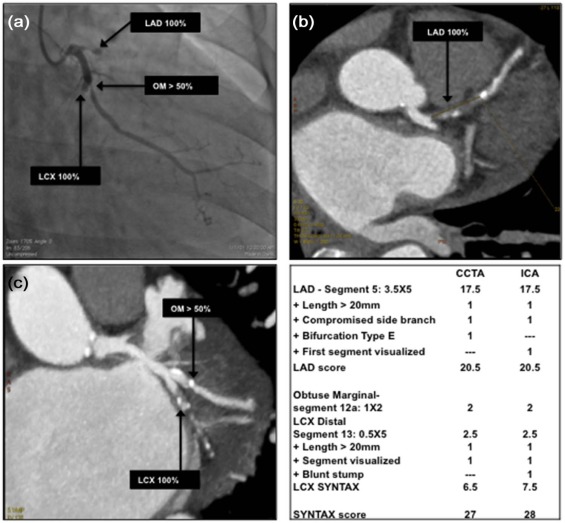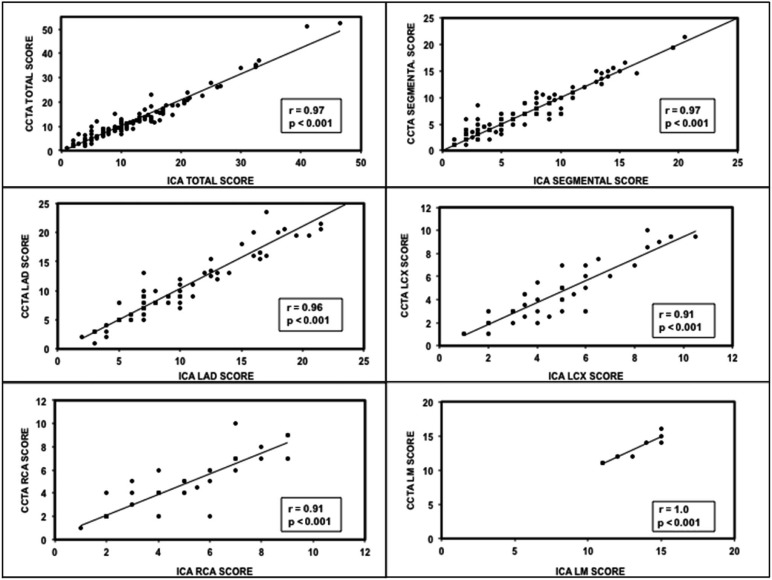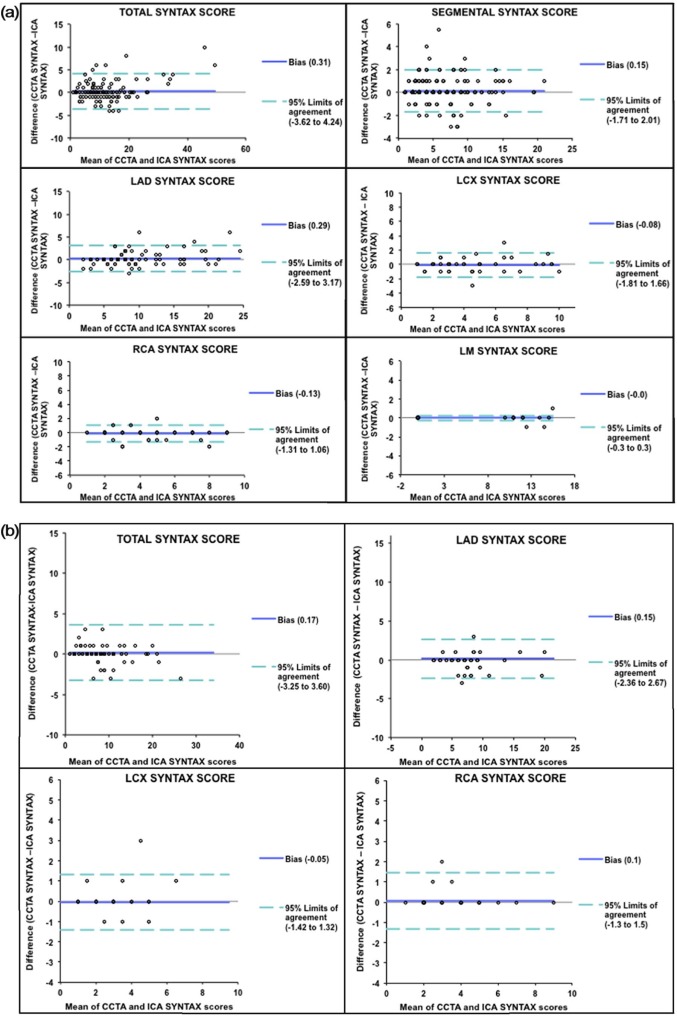Highlights
SYNTAX score commonly assesses coronary artery disease complexity by invasive coronary angiography (ICA).
SYNTAX scores derived from coronary computed tomography angiography (CCTA) are concordant with those derived from ICA.
CCTA- and ICA-derived SYNTAX scores correlate with complexity of percutaneous coronary intervention.
Derivation of SYNTAX score by CCTA might assist in percutaneous coronary intervention planning.
Rationale and Objectives
Get Radiology Tree app to read full this article<
Materials and Methods
Get Radiology Tree app to read full this article<
Results
Get Radiology Tree app to read full this article<
Conclusion
Get Radiology Tree app to read full this article<
Introduction
Get Radiology Tree app to read full this article<
Get Radiology Tree app to read full this article<
Get Radiology Tree app to read full this article<
Materials and Methods
Study Population
Get Radiology Tree app to read full this article<
Get Radiology Tree app to read full this article<
Get Radiology Tree app to read full this article<
CCTA Image Acquisition
Get Radiology Tree app to read full this article<
CCTA Image Reconstruction and Evaluation
Get Radiology Tree app to read full this article<
Get Radiology Tree app to read full this article<
ICA Image Acquisition and Evaluation
Get Radiology Tree app to read full this article<
Get Radiology Tree app to read full this article<
Complexity of PCI
Get Radiology Tree app to read full this article<
Get Radiology Tree app to read full this article<
Get Radiology Tree app to read full this article<
Get Radiology Tree app to read full this article<
Statistical Methods
Get Radiology Tree app to read full this article<
Results
Patient Characteristics
Get Radiology Tree app to read full this article<
TABLE 1
Baseline Characteristics
n = 154 Age (years) \* 66 ± 12 Male gender 107 (69) Hypertension 101 (65) Dyslipidemia 118 (76) Diabetes mellitus 38 (24) Current cigarette smoking 30 (19) Family history of premature CAD 62 (40) BMI (Kg/m 2 ) \* 27 ± 5 Previous MI 16 (10) Previous PCI 22 (14) Baseline creatinine (mg/dL) \* 1.07 ± 0.9 Baseline glomerular filtration rate \* (mL/min/1.73 m 2 ) 85 ± 27 Agatston coronary calcium score (n = 127) † 377 (148–940)
BMI, body mass index; CAD, coronary artery disease; MI, myocardial infarction; PCI, percutaneous coronary intervention.
Get Radiology Tree app to read full this article<
Get Radiology Tree app to read full this article<
Agreement and Reproducibility of CCTA- and ICA-Derived SYNTAX Scores
Get Radiology Tree app to read full this article<
TABLE 2
Reproducibility Analyses—Inter-Observer Variability Between ICA Readers, CCTA Readers, as Well as Intra-observer Variability for Each of the CCTA Readers
SYNTAX Score Tertiles \* Number of Obstructive Lesions Bifurcation Lesions Total Occlusions Inter-observer variability ICA 0.81(0.71–0.92) 0.94(0.91–0.97) 0.64(0.55–0.74) 0.96(0.91–1.0) CCTA 0.85(0.76–0.94) 0.95(0.93–0.96) 0.71(0.59–0.84) 0.95(0.9–1.0) Intra-observer variability CCTA 1st reader 0.85(0.69–1.0) 0.94(0.90–0.99) 0.71(0.53–0.90) 1.0 CCTA 2nd reader 0.78(0.61–0.94) 0.98(0.96–1.0) 0.79(0.63–0.95) 0.86(0.67–1.0)
CCTA, coronary computed tomographic angiography; ICA, invasive coronary angiography.
Get Radiology Tree app to read full this article<
Get Radiology Tree app to read full this article<
Get Radiology Tree app to read full this article<
TABLE 3
SYNTAX CAD Variables: Comparison Between ICA and CCTA for 285 Lesions Considered Obstructive by Both
SYNTAX
Components \* Identified by ICA Correctly Diagnosed by CCTA (%) Agreement Between ICA and CCTA Total occlusion 36 34 (94) 0.94 (0.90–0.98) Bridging collaterals 19 9 (47) 0.63 (0.42–0.84) Compromised side branch 10 9 (90) 0.65 (0.44–0.86) Blunt stump 14 0 (0) 0 Segment visualized beyond occlusion 14 9 (64) 0.68 (0.47–0.89) Aorto-ostial lesion 7 5 (57) 0.66 (0.38–0.94) Bifurcation/trifurcation 73 53 (76) 0.56 (0.46–0.66) Length >20 mm 53 31 (58) 0.53 (0.38–0.69) Heavy calcification 28 24 (86) 0.76 (0.63–0.89) Intracoronary thrombus 2 0 (0) 0 Diffuse disease 19 13 (68) 0.63 (0.42–0.83)
CAD, coronary artery disease; CCTA, coronary computed tomographic angiography; ICA, invasive coronary angiography.
Agreement is presented as kappa values (95% confidence intervals).
Get Radiology Tree app to read full this article<
Get Radiology Tree app to read full this article<
Comparison Between Patients Referred to PCI vs CABG or Medical Therapy
Get Radiology Tree app to read full this article<
Get Radiology Tree app to read full this article<
Get Radiology Tree app to read full this article<
Get Radiology Tree app to read full this article<
TABLE 4
CCTA- and ICA-derived Per-patient and Segmental SYNTAX Scores According to Therapeutic Approach
Per Patient SYNTAX Score Medical Management ( n = 26 Patients) PCI ( n = 113) CABG ( n = 15) CCTA 6.8 ± 4.1 10.3 ± 6.3 23.5 ± 14.6 \* , † ICA 7.2 ± 5.4 10.1 ± 6.1 21.7 ± 12.1 \* , † Segmental SYNTAX score Medical management (n = 78 lesions) PCI (n = 154 lesions) CABG (n = 48 lesions) CCTA 4.9 ± 3.7 5.3 ± 3.5 6.4 ± 4.5 \* ICA 5.0 ± 3.8 5.5 ± 3.5 6.5 ± 4.4 \*
CCTA, coronary computed tomographic angiography; CABG, coronary artery bypass graft; ICA, invasive coronary angiography; PCI, percutaneous coronary intervention.
Get Radiology Tree app to read full this article<
Get Radiology Tree app to read full this article<
Get Radiology Tree app to read full this article<
Secondary Analysis of Patients Undergoing PCI
Get Radiology Tree app to read full this article<
Total Contrast Volume
Get Radiology Tree app to read full this article<
TABLE 5
Total Fluoroscopy Time and Contrast Volume According to Total and Segmental SYNTAX Score Tertiles Among PCI Subgroup (n = 113)
1st Tertile 2nd Tertile 3rd Tertile P Value Overall SYNTAX score ICA Mean ± SD Contrast volume (mL) 153.4 ± 62.7 193.0 ± 64.8 251.7 ± 139.4 <0.001 Total fluoroscopy time (min) 12.7 ± 9.2 16.4 ± 9.8 22.1 ± 14.6 <0.001 CCTA Contrast volume (ml) 152.7 ± 62.7 188.6 ± 63.7 251.8 ± 133.6 <0.001 Total fluoroscopy time (min) 12.6 ± 9.0 17.0 ± 10.4 21.5 ± 14.2 <0.001 Segmental SYNTAX scores ICA Mean ± SD Contrast volume (mL) 135.7 ± 43.2 184.2 ± 59.2 222.7 ± 127.1 <0.01 Total fluoroscopy time (min) 10.6 ± 4.8 17 ± 11.6 18.7 ± 12.5 0.02 CCTA Contrast volume (mL) 144.3 ± 49 194.3 ± 68.4 215.4 ± 125.5 0.01 Total fluoroscopy time (min) 11.5 ± 7.9 19.2 ± 11.6 17.5 ± 12 0.03
CCTA, coronary computed tomographic angiography; ICA, invasive coronary angiography; PCI, percutaneous coronary intervention.
Get Radiology Tree app to read full this article<
Get Radiology Tree app to read full this article<
Total Fluoroscopy Time
Get Radiology Tree app to read full this article<
Get Radiology Tree app to read full this article<
Procedure Failure or Complication
Get Radiology Tree app to read full this article<
Discussion
Get Radiology Tree app to read full this article<
Get Radiology Tree app to read full this article<
Get Radiology Tree app to read full this article<
Get Radiology Tree app to read full this article<
Get Radiology Tree app to read full this article<
Get Radiology Tree app to read full this article<
Get Radiology Tree app to read full this article<
Get Radiology Tree app to read full this article<
Get Radiology Tree app to read full this article<
Get Radiology Tree app to read full this article<
Supplementary Data
Get Radiology Tree app to read full this article<
Appendix S1
Get Radiology Tree app to read full this article<
Get Radiology Tree app to read full this article<
Get Radiology Tree app to read full this article<
Get Radiology Tree app to read full this article<
References
1. Sianos G., Morel M.-A., Kappetein A.P., et. al.: The SYNTAX Score: an angiographic tool grading the complexity of coronary artery disease. EuroIntervention 2005; 1: pp. 219-227.
2. Raff G.L., Gallagher M.J., Oein O., et. al.: Diagnostic accuracy of noninvasive coronary angiography using 64-slice spiral computed tomography. J Am Coll Cardiol 2005; 46: pp. 552-557.
3. Miller J.M., Rochitte C.E., Dewey M., et. al.: Diagnostic performance of coronary angiography by 64-row CT. N Engl J Med 2008; 359: pp. 2324-2336.
4. Budoff M.J., Dowe D., Jollis J.G., et. al.: Diagnostic performance of 64-multidetector row coronary computed tomographic angiography for evaluation of coronary artery stenosis in individuals without known coronary artery disease: results from the prospective multicenter ACCURACY (Assessment by Coronary Computed Tomographic Angiography of Individuals Undergoing Invasive Coronary Angiography) trial. J Am Coll Cardiol 2008; 52: pp. 1724-1732.
5. Meijboom W.B., Meijs M.F.L., Schuijf J.D., et. al.: Diagnostic accuracy of 64-slice computed tomography coronary angiography: a prospective, multicenter, multivendor study. J Am Coll Cardiol 2008; 52: pp. 2135-2144.
6. Ferencik M., Ropers D., Abbara S., et. al.: Diagnostic accuracy of image postprocessing methods for the detection of coronary artery stenoses by using multidetector CT. Radiology 2007; 243: pp. 696-702.
7. Cheng V., Gutstein A., Wolak A., et. al.: Moving beyond binary grading of coronary arterial stenoses on coronary computed tomographic angiography: insights for the imager and referring clinician. JACC Cardiovasc Imaging 2008; 1: pp. 460-471.
8. Leaman D.M., Brower R.W., Meester G.T., et. al.: Coronary artery atherosclerosis: severity of the disease, severity of angina pectoris and compromised left ventricular function. Circulation 1981; 63: pp. 285-299.
9. Levey A.S., Stevens L.A., Schmid C.H., et. al.: A new equation to estimate glomerular filtration rate. Ann Intern Med 2009; 150: pp. 604-612.
10. Harjai K.J., Raizada A., Shenoy C., et. al.: A comparison of contemporary definitions of contrast nephropathy in patients undergoing percutaneous coronary intervention and a proposal for a novel nephropathy grading system. Am J Cardiol 2008; 101: pp. 812-819.
11. Serruys P.W., Onuma Y., Garg S., et. al.: Assessment of the SYNTAX score in the Syntax study. EuroIntervention 2009; 5: pp. 50-56.
12. Garg S., Girasis C., Sarno G., et. al.: The SYNTAX score revisited: a reassessment of the SYNTAX score reproducibility. Catheter Cardiovasc Interv 2010; 75: pp. 946-952.
13. Valgimigli M., Serruys P.W., Tsuchida K., et. al.: Cyphering the complexity of coronary artery disease using the syntax score to predict clinical outcome in patients with three-vessel lumen obstruction undergoing percutaneous coronary intervention. Am J Cardiol 2007; 99: pp. 1072-1081.
14. Serruys P.W., Morice M.-C., Kappetein A.P., et. al.: Percutaneous coronary intervention versus coronary-artery bypass grafting for severe coronary artery disease. N Engl J Med 2009; 360: pp. 961-972.
15. Wykrzykowska J.J., Garg S., Girasis C., et. al.: Value of the SYNTAX score for risk assessment in the all-comers population of the randomized multicenter LEADERS (Limus Eluted from a durable versus ERodable stent coating) trial. J Am Coll Cardiol 2010; 56: pp. 272-277.
16. Voros S., Rinehart S., Qian Z., et. al.: Coronary atherosclerosis imaging by coronary CT angiography: current status, correlation with intravascular interrogation and meta-analysis. JACC Cardiovasc Imaging 2011; 4: pp. 537-548.
17. Min J.K., Shaw L.J., Devereux R.B., et. al.: Prognostic value of multidetector coronary computed tomographic angiography for prediction of all-cause mortality. J Am Coll Cardiol 2007; 50: pp. 1161-1170.
18. Hulten E.A., Carbonaro S., Petrillo S.P., et. al.: Prognostic value of cardiac computed tomography angiography: a systematic review and meta-analysis. J Am Coll Cardiol 2011; 57: pp. 1237-1247.
19. Min J.K., Dunning A., Lin F.Y., et. al.: Age- and sex-related differences in all-cause mortality risk based on coronary computed tomography angiography findings results from the International Multicenter CONFIRM (COroNary CT Angiography Evaluation For Clinical Outcomes: An InteRnational Multicenter Registry) of 23,854 patients without known coronary artery disease. J Am Coll Cardiol 2011; 58: pp. 849-860.
20. Rana J.S., Dunning A., Achenbach S., et. al.: Differences in prevalence, extent, severity, and prognosis of coronary artery disease among patients with and without diabetes undergoing coronary computed tomography angiography: results from 10,110 individuals from the CONFIRM (COroNary CT Angiography Evaluation For Clinical Outcomes: An InteRnational Multicenter Registry). Diabetes Care 2012; 35: pp. 1787-1794.
21. Chow B.J.W., Small G., Yam Y., et. al.: Incremental prognostic value of cardiac computed tomography in coronary artery disease using CONFIRM: COroNary CT Angiography Evaluation For Clinical Outcomes: An InteRnational Multicenter Registry. Circ Cardiovasc Imaging 2011; 4: pp. 463-472.
22. Villines T.C., Hulten E.A., Shaw L.J., et. al.: Prevalence and severity of coronary artery disease and adverse events among symptomatic patients with coronary artery calcification scores of zero undergoing coronary computed tomography angiography: results from the CONFIRM (COroNary CT Angiography Evaluation For Clinical Outcomes: An InteRnational Multicenter Registry). J Am Coll Cardiol 2011; 58: pp. 2533-2540.
23. Papadopoulou S.-L., Girasis C., Dharampal A., et. al.: CT-SYNTAX score: a feasibility and reproducibility study. JACC Cardiovasc Imaging 2013; 6: pp. 413-415.
24. Mollet N.R., Hoye A., Lemos P.A., et. al.: Value of preprocedure multislice computed tomographic coronary angiography to predict the outcome of percutaneous recanalization of chronic total occlusions. Am J Cardiol 2005; 95: pp. 240-243.
25. Soon K.H., Cox N., Wong A., et. al.: CT coronary angiography predicts the outcome of percutaneous coronary intervention of chronic total occlusion. J Interv Cardiol 2007; 20: pp. 359-366.
26. García-García H.M., van Mieghem C.A.G., Gonzalo N., et. al.: Computed tomography in total coronary occlusions (CTTO registry): radiation exposure and predictors of successful percutaneous intervention. EuroIntervention 2009; 4: pp. 607-616.
27. Hsu J.T., Kyo E., Chu C.M., et. al.: Impact of calcification length ratio on the intervention for chronic total occlusions. Int J Cardiol 2011; 150: pp. 135-141.
28. Stähli B.E., Bonassin F., Goetti R., et. al.: Coronary computed tomography angiography indicates complexity of percutaneous coronary interventions. J Invasive Cardiol 2012; 24: pp. 196-201.
29. Wertman B.M., Cheng V.Y., Kar S., et. al.: Characterization of complex coronary artery stenosis morphology by coronary computed tomographic angiography. JACC Cardiovasc Imaging 2009; 2: pp. 950-958.
30. Meijboom W.B., Van Mieghem C.A.G., van Pelt N., et. al.: Comprehensive assessment of coronary artery stenoses: computed tomography coronary angiography versus conventional coronary angiography and correlation with fractional flow reserve in patients with stable angina. J Am Coll Cardiol 2008; 52: pp. 636-643.
31. Schuijf J.D., Wijns W., Jukema J.W., et. al.: Relationship between noninvasive coronary angiography with multi-slice computed tomography and myocardial perfusion imaging. J Am Coll Cardiol 2006; 48: pp. 2508-2514.
32. Nam C.-W., Mangiacapra F., Entjes R., et. al.: Functional SYNTAX score for risk assessment in multivessel coronary artery disease. J Am Coll Cardiol 2011; 58: pp. 1211-1218.


